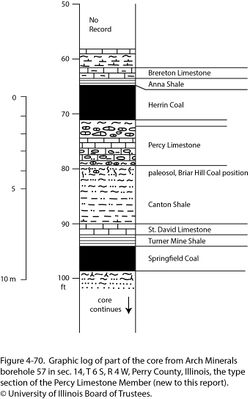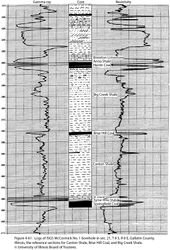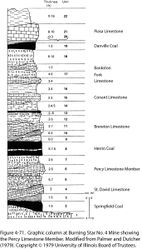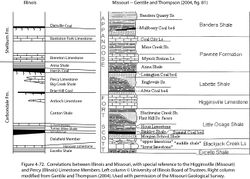Percy Limestone Member
Lithostratigraphy: Carbondale Formation >>Percy Limestone Member
Chronostratigraphy: Paleozoic Erathem >>Pennsylvanian Subsystem >>Desmoinesian Series
Allostratigraphy: Absaroka Sequence
Primary source
Nelson, W.J., P.H. Heckel and J.M. Obrad, 2022, Pennsylvanian Subsystem in Illinois: Illinois State Geological Survey, Bulletin (in press).
Contributing author(s)
W.J. Nelson
Name
Original description
The name Percy Limestone Member is hereby proposed for a limestone unit that lies a short distance below the Herrin Coal and is clearly separate from the older St. David Limestone Member.
Derivation
The name refers to the village of Percy in Randolph County, about 6 mi (10 km) west of the borehole that serves as the type section. Callary (2009) remarked, “The namesake is probably Percy Kampen, son of the superintendent of the Kampenville Mine, although local tradition claims the community was named for the engineer who drove the first train through the town.”
Other names
This unit has been identified as the Higginsville Limestone, but on further consideration, the Percy may be younger than the Higginsville (see below).
History/background
The Percy Limestone is known from surface coal mining and core drilling chiefly in Perry and Randolph Counties, on the Sparta Shelf in southwestern Illinois.
Type section
Type location
No suitable surface exposures being known, a section from a drill core is chosen. This is Arch Minerals borehole #57, drilled in sec. 14, T 6 S, R 4 W, Perry County, Illinois (ISGS county no. 90099). The limestone is 7.0 ft (2.1 m) thick and lies in the depth interval of 72.1 to 79.1 ft (22.0 to 24.1 m; Figure 4-70).
Type author(s)
Present report.
Type status
The core description is on file in the ISGS Geological Records Unit and is available via the ISGS website. Core is archived at the ISGS Geological Samples Library in Champaign (storage number C-12951).
Reference section
None.
Stratigraphic relationships
The Percy Limestone Member directly underlies the underclay of the Herrin Coal and is separated from the older St. David Limestone by shale, siltstone, and sandstone 2 to 20 ft (0.6 to 6.1 m) thick. The critical question of whether the Percy is older or younger than the Briar Hill Coal is obscured by the fact that the Briar Hill is absent in the area where the Percy is well developed. However, in the type section, the Percy rests on a truncated paleosol that is believed to mark the position of the Briar Hill Coal (Figure 4-61). A section from the Burning Star No. 4 surface mine (Figure 4-71) also shows nonfissile mudstone beneath the Percy, suggesting paleosol beneath the Briar Hill.
The Higginsville Limestone of the Midcontinent has lithology and fossils similar to the Percy and occupies approximately the same stratigraphic position (Jewett 1945; Howe and Koenig 1961; Heckel 1999; Gentile and Thompson 2004). However, if the Alvis Coal Bed of Missouri is the same as the Briar Hill Coal Member in Illinois, then the Percy Limestone is younger than the Higginsville (Figure 4-72).
|
Extent and thickness
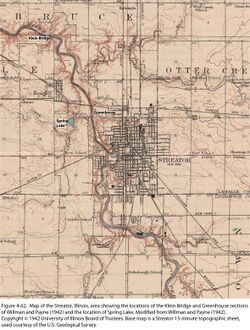
The Percy Limestone is best developed in southern Perry and northeastern Randolph Counties in southwestern Illinois, where the limestone was formerly exposed in large surface coal mines (Figure 4-62). Closer to St. Louis, the Percy has been recognized in cores from St. Clair County and tentatively from outcrops in southern Calhoun County. The maximum thickness in Illinois is about 10 ft (3.0 m). Bedded to nodular limestone occurs within or beneath the Herrin underclay in large areas of the Illinois Basin. This rock is largely microgranular and nonfossiliferous and may represent calcrete or pedogenic carbonate developed during paleosol formation. Pedogenic carbonates should be distinguished from the marine Percy Limestone of Perry and Randolph Counties.
Lithology
In Illinois, color varies from light to medium gray and brown and is commonly mottled. The texture varies from microgranular (most common) to skeletal packstone and grainstone (as seen in the middle and lower part in the type core). In addition, the limestone in the core contains bright green glauconite grains. The rock is commonly very argillaceous to silty. A nodular structure is common; nodular limestone may grade to isolated limestone nodules in a green to gray mudstone matrix. The upper part is rooted and brecciated and contains karst features.
Core(s)
Photograph(s)
Contacts
The lower contact may be sharp but tends to be gradational and irregular. The upper contact is generally gradational and very irregular through a transition zone of claystone with limestone nodules.
Well log characteristics
As shown by logs in the type area, the log response is typical for argillaceous limestone.
Fossils
Echinoderm fragments and brachiopods, including productids, are common. Worthen (1868) listed the gastropods Bellerophon and Naticopsis, the brachiopod Spirifer, and the sponge Chaetetes in St. Clair County.
Age and correlation
The Percy Limestone may not have a direct correlative in the Midcontinent (Figure 4-72). In Indiana, the Antioch Limestone Member may be a Higginsville correlative.
Environments of deposition
Shallow marine, open shelf to a restricted lagoon. The unit records a transgressive–regressive cycle. The top of the limestone was exposed and underwent pedogenesis.
Economic importance
None.
Remarks
References
- Callary, E., 2009, Place names of Illinois: Urbana, University of Illinois Press, 425 p.
- Gentile, R.J., and T.L. Thompson, 2004, Paleozoic succession in Missouri, Part 5, Pennsylvanian Subsystem, Volume A, Morrowan strata through Cherokee Group: Missouri Geological Survey, Report of Investigations 70, 241 p. and correlation chart.
- Heckel, P.H., 1999, Middle and Upper Pennsylvanian (Upper Carboniferous) cyclothem succession in Midcontinent Basin, U.S.A.: Kansas Geological Survey, Open-File Report 99-27, 236 p.
- Howe, W.B., and J.W. Koenig, 1961, The stratigraphic succession in Missouri: Missouri Geological Survey and Water Resources, v. 40, 2nd Series, 183 p. and chart.
- Jewett, J.M., 1945, Stratigraphy of the Marmaton group, Pennsylvanian, in Kansas: Kansas Geological Survey, Bulletin 58, 148 p.
- Palmer, J.E., and R.R. Dutcher, 1979, Depositional and structural history of the Pennsylvanian System in the Illinois Basin, Part 1, road log and descriptions of stops: Illinois State Geological Survey, Guidebook Series 15, 116 p.
- Willman, H.B., and J.N. Payne, 1942, Geology and mineral resources of the Marseilles, Ottawa, and Streator Quadrangles: Illinois State Geological Survey, Bulletin 66, 388 p., 29 pls.
- Worthen, A.H., 1868, Geology and palaeontology: Geological Survey of Illinois, v. 3, 574 p., 20 pls.
ISGS Codes
| Stratigraphic Code | Geo Unit Designation |
|---|---|
